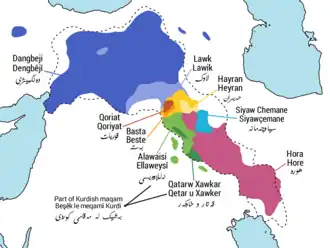Hayran (vocal style)

Hayran (Kurdish: حەیران, romanized: Ĥeyran, Kurdish pronunciation: [ħɛjˈɾɑːn]) is a form of Kurdish vocal music, performed without instrumental accompaniment, though sometimes with music; It typically consists of several short lyrical verses. The singer of a hayran often addresses personal experiences, such as the hardships of life or expressions of love. In many cases, the performer may also use third-person narrative to recount an impactful story or a significant historical event.[1][2][3]
Hayran is a type of poetic expression.[4]
Etymology
The word hayran means "lover", "longing one", "enamored", or "enchanted".[5][6] According to the Kurdistan Dictionary, the term refers to one of the oldest forms of Kurdish songs.[7][8]
History
The origins of hayran are generally traced back to the ancient civilizations of Mesopotamia.[9] However, some accounts suggest that hayran may have developed during the feudal period, as it was reportedly favored by local nobility (Aghas).[10]
The main region associated with the emergence and development of hayran is the plains of Hewlêr (Erbil).[11][12][13] It later spread from Hewlêr to other regions of Kurdistan.[14]
Types
Hayran can be categorized into two primary musical forms: Serçiyayî (Kurdish: سەرچیایی) and Mecilîsî (Kurdish: مەجلیسی).[15] Each type has distinct stylistic and performative characteristics that reflect the context in which it is traditionally performed.[16][17][18]
Serçiyayî

Serçiyayî is a type of hayran that is sung in a loud voice. The vocalist's voice must have a high range and maintain a strong projection throughout the performance.[19] During the performance, the volume of the voice gradually increases.[20]
Mecilîsî

Mecilîsî is a type of hayran traditionally performed in teahouses and local gatherings. It is characterized by a spontaneous delivery, using a low and quiet voice. This style does not require strong vocal projection or intense vocal effort, which makes it accessible to a wide range of singers.[21][20]
If a hayran consists of fewer than three rhyme units, Serbend, Nawbend, and Duabend, it is considered incomplete and is not regarded as a true hayran.[22]
Notable performers
The following individuals are known for their contributions to the performance and preservation of hayran:
- Xidir Girdgirawî[23]
- Seyd Badaweyi[24]
- Cemîl 'Elyaweyi[24]
- Nadir Siyan[25]
- 'Umer Gawereyi[25]
- Ĥesen Sîsaweyî[26]
- 'Ereb 'Usman[27][28]
- Řesûll Gerdi[29]
- Ĥesen Ĥeyran[30]
See also
References
- ^ Mexmuri 2001, pp. 5.
- ^ M. Baqlawayi, Eraj (1984). Keşkollî Kellaterzan: Gencîney pizîşikî ĥekîmaney Kurdewarî (in Kurdish). Sanandaj, Iran: Roj Publisher. p. 82.
- ^ "چیرۆک، ڕێگەیەک بۆ گێڕانەوەی مێژوو". JINHAGENCY News (in Kurdish). Retrieved 4 August 2025.
- ^ Sincawî 2010, pp. 67.
- ^ Sharafkandi, Abdurrahman (1991). Hanbāna'borina (in Kurdish). Surūsh.
- ^ "Definition and meaning of "Hayran"". www.almaany.com (in Arabic). Almaany. Retrieved 4 August 2025.
- ^ "Definition of Hayran". bradost.net. Wişedan Network. Retrieved 4 August 2025.
- ^ Mukryiani, Giwi (1999). Ferhengî Kurdistan | Kurdi-Kurdi [Kurdistan Dictionary | Kurdish-Kurdish] (in Kurdish). Aras Publisher.
- ^ Fayaq, Pasar (3 September 2022). "Mustafa Dadar about Hayran". www.rudaw.net (in Kurdish). RMN. Retrieved 4 August 2025.
- ^ Mexmuri 2001, pp. 59.
- ^ Mexmuri 2001, pp. 61.
- ^ Sincawî 2010, pp. 26.
- ^ "چۆڵەچرا؛ بەیت، بەند، حەیران و هەوای ناوچەکانی موکریان". www.rudaw.net. 7 January 2021. Retrieved 4 August 2025.
- ^ Sincawî 2010, pp. 27.
- ^ Sincawî 2010, pp. 18.
- ^ Mexmuri 2001, pp. 36.
- ^ Shekhani, Saadullah; Jutyar, Xalid (1990). Hayran and Margi Xariban. Baghdad, Iraq: Al-Hoodath. p. 19.
- ^ "الحيران مقام الحب الكردي الرخيم". Iraqi Network Magazine (in Arabic). Retrieved 4 August 2025.
- ^ Mexmuri 2001, pp. 34.
- ^ a b Sincawî 2010, pp. 20.
- ^ Mexmuri 2001, pp. 35.
- ^ Sincawî 2010, pp. 40.
- ^ Mexmuri 2001, pp. 86.
- ^ a b Mexmuri 2001, pp. 87.
- ^ a b Mexmuri 2001, pp. 88.
- ^ "Machko teahouse in Erbil, Kurdistan Region". rojnews.news. Roj News. 26 February 2021. Retrieved 11 August 2025.
- ^ Salah, Hiwa (20 February 2019). "Arab Osman on Erbil's hayran style". www.rudaw.net. Rudaw Media Network. Retrieved 4 August 2025.
- ^ "عارهب عوسمان بهرههمی گوڵ خونچە بڵاودهكاتەوە". Kurdistan 24 (in Kurdish). Erbil, Kurdistan Region. 15 June 2023. Retrieved 5 August 2025.
- ^ Dillbend, Nazim (30 July 2025). "Řesûll Gerdi". gilkend.com. Gillkend - گڵکەند. Retrieved 11 August 2025.
- ^ Salah, Hiwa (16 July 2017). "٣٣ ساڵ بەسەر کۆچی دوایی حەسەن حەیران تێدەپەڕێت". www.rudaw.net. Rudaw Media Network. Retrieved 4 August 2025.
Sources
- Mexmuri, Xefur (2001). Heyran, çemik, naweřok, serhelldan [Hayran, concept, content, origin] (in Kurdish). Erbil, Kurdistan Region: Aras Publisher (published 2004).
- Sincawî, Cemîl (2010). Heyran u Çend Boçûnêkî tir (PDF) (in Kurdish). Erbil, Kurdistan Region: Senterî Řoşinbîrî u Hûnerî Qereçûx.